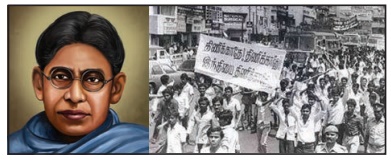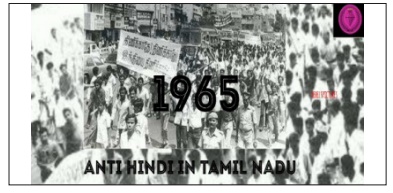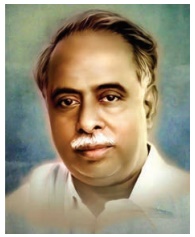Anti Hindi Agitation
The decline of the Justice Party and Periyar’s refusal to enter into electoral politics together with the growing popularity of Mahatma Gandhi, enabled Indian National Congress to win elections in the Madras Presidency in 1937 and Rajagopalachari became the premier.
He introduced total prohibition (ban on liquor) and abolished the Zamindari system, and introduced legislations removing restrictions on temple entry for the depressed classes. Yet his measures leading to closure of many schools and introduction of Hindi as compulsory language in schools provoked the admirers of self respect and Tamil Nationalists like Mariamalai Adigal to organize the ‘Anti Hindi Movement’ in 1937.
Thousands of agitators including E.V.Ramaswamy courted arrests, and a number of agitators died in prison.

Salem Conference, 1944
In 1944, at Salem conference under the leadership of Periyar, a historic resolution was moved to change the name of Justice Party to Dravidar Kazhagam (DK). Periyar organised ‘Dravida Nadu’ conference and demanded an independent homeland for ‘Dravidians’. Further, he pronounced his very famous slogan ‘Dravida Nadu for Dravidians’ at the conference.
Apart from separate ‘Dravida Nadu’ demand, the Dravidar Kazhagam wanted to establish casteless society, condemned religious rituals, traditions and superstitious in Dravidian society. The Dravidar Kazhagam became very popular in many rural and urban masses, especially among the students. Many non-Brahmin leaders and students have changed their name reflecting Tamil Identity.
Anti-Hindi Agitation 1965

In accordance with the provisions of Article 313 of the Indian Constitution Hindi was made as the official language of the Indian Union on January 26, 1965. In order to protest the decision of the Union Government the Dravida Munnetra Kazhagam decided to observe 26th January, 1965 as a ‘Day of Mourning’. Many leaders of the party and its cadres were arrested. Tamil Nadu had witnessed a large scale of Anti-Hindi agitations. Because of the agitations the cause secured considerable amount of support among the student community. On the other hand the Congress party lost its base and support in the state of Tamil Nadu. Meanwhile, the Dravida Munnetra Kazhagam had withdrawn the demand for ‘Dravida Nadu’ and continue to actively participate in the electoral politics of Tamilnadu and became a ruling party in the state.
Dravidian Movement during second World War and after

In 1939, the congress protested the government’s declaration involving India in the Second World War which led to the resignation of congress ministry. In Madras Presidency Rajaji’s ministry had resigned but Periyar raised the demand of Dravida Nadu on the ground that independence prior to socio-cultural equality would be injurious to Tamil interests. In 1949, Dravidar Kazhagam split and Dravida Munnetra Kazhagam was formed.
In 1951, the Supreme Court struck down communal reservations in higher education. Immediately Periyar launched a major agitation for the restoration of communal reservation.

Consequently, the first constitutional amendment Act was passed in the Parliament in favour of reservations for socially and educationally backward classes.














